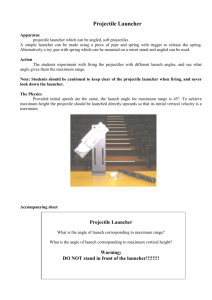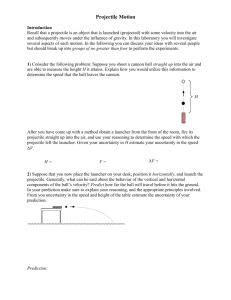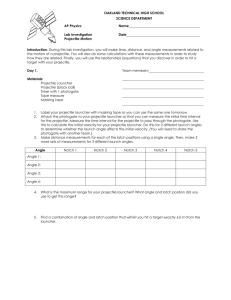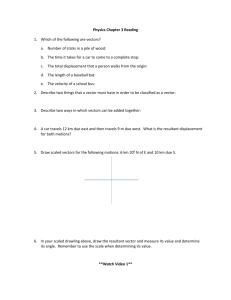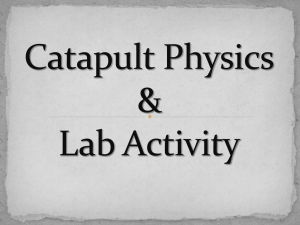Experiment 2: Projectile Motion
advertisement
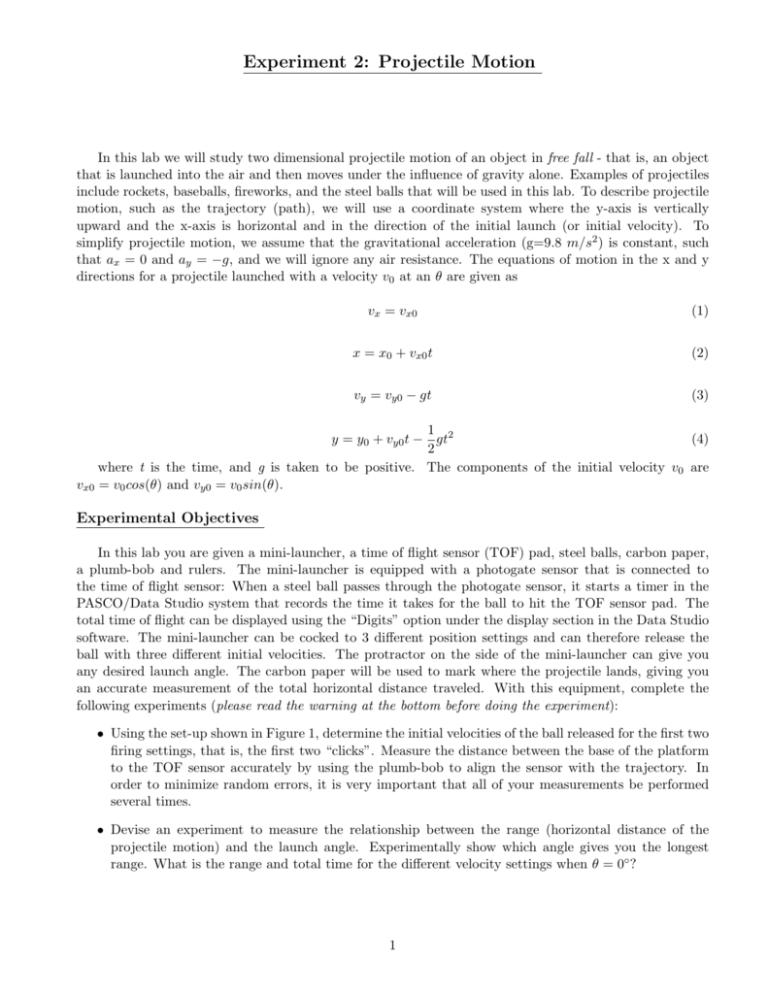
Experiment 2: Projectile Motion In this lab we will study two dimensional projectile motion of an object in free fall - that is, an object that is launched into the air and then moves under the influence of gravity alone. Examples of projectiles include rockets, baseballs, fireworks, and the steel balls that will be used in this lab. To describe projectile motion, such as the trajectory (path), we will use a coordinate system where the y-axis is vertically upward and the x-axis is horizontal and in the direction of the initial launch (or initial velocity). To simplify projectile motion, we assume that the gravitational acceleration (g=9.8 m/s2 ) is constant, such that ax = 0 and ay = −g, and we will ignore any air resistance. The equations of motion in the x and y directions for a projectile launched with a velocity v0 at an θ are given as vx = vx0 (1) x = x0 + vx0 t (2) vy = vy0 − gt (3) 1 y = y0 + vy0 t − gt2 (4) 2 where t is the time, and g is taken to be positive. The components of the initial velocity v0 are vx0 = v0 cos(θ) and vy0 = v0 sin(θ). Experimental Objectives In this lab you are given a mini-launcher, a time of flight sensor (TOF) pad, steel balls, carbon paper, a plumb-bob and rulers. The mini-launcher is equipped with a photogate sensor that is connected to the time of flight sensor: When a steel ball passes through the photogate sensor, it starts a timer in the PASCO/Data Studio system that records the time it takes for the ball to hit the TOF sensor pad. The total time of flight can be displayed using the “Digits” option under the display section in the Data Studio software. The mini-launcher can be cocked to 3 different position settings and can therefore release the ball with three different initial velocities. The protractor on the side of the mini-launcher can give you any desired launch angle. The carbon paper will be used to mark where the projectile lands, giving you an accurate measurement of the total horizontal distance traveled. With this equipment, complete the following experiments (please read the warning at the bottom before doing the experiment): • Using the set-up shown in Figure 1, determine the initial velocities of the ball released for the first two firing settings, that is, the first two “clicks”. Measure the distance between the base of the platform to the TOF sensor accurately by using the plumb-bob to align the sensor with the trajectory. In order to minimize random errors, it is very important that all of your measurements be performed several times. • Devise an experiment to measure the relationship between the range (horizontal distance of the projectile motion) and the launch angle. Experimentally show which angle gives you the longest range. What is the range and total time for the different velocity settings when θ = 0◦ ? 1 θ ymax H TOF d Figure 1: A projectile is launched at an angle θ off a platform with height H above the around. The projectile lands the on time of flight sensor (TOF), a distance d away from the base of the platform. • Devise an experiment to measure the acceleration due to gravity using the TOF sensor, assuming you do not know the initial velocities of the launcher (Hint: try a free-fall experiment). Do enough trials to reasonably compare your results with the accepted value of g = 9.80 m/s2 . What are possible sources of error for this experiment? WARNING: THE PROJECTILE LAUNCHER CAN SHOOT STEEL BALLS AT HIGH VELOCITIES. IF A PROJECTILE WERE TO HIT YOU IN THE FACE IT COULD CAUSE PERMANENT DAMAGE! ALWAYS WEAR SAFETY GOGGLES WHEN OPERATING THE LAUNCHER! NEVER FIRE THE LAUNCHER WHEN SOMEONE IS DIRECTLY IN FRONT OF THE LAUNCHER, NO MATTER HOW FAR AWAY THEY SEEM TO BE! NEVER EVER POINT THE LAUNCHER AT YOUR FACE! VIOLATING ANY OF THESE SAFETY RULES WILL RESULT IN LOST POINTS AND A POSSIBLE EXPULSION FROM THE LABORATORY. HORSEPLAY IS NOT TOLERATED AT ALL! REMEMBER, IT IS ONLY FUNNY UNTIL SOMEONE LOSES AN EYE! AND PLEASE DO NOT STEP ON THE TIME OF FLIGHT SENSOR PAD. A full lab report is not necessary for this lab. Answer the questions on the following page and turn it in with your signed datasheet. 2 PHYS 123, Lab 2 Questions Name: CWID: Write your answers on a separate sheet and attach your signed datasheet when turning it in. You must show all of your work for full credit. Make it clear to me you understand what you’re doing. Any graphs or tables should be made via computer software and attached to this handout. 1. Answer the following questions using the data you acquired in this experiment: (a) What are the two initial velocities for the first two firing settings (the first two “clicks”)? Make a table consisting of the initial velocities, its components vx and vy , the launch angles, the time of flight, and the horizontal range. (b) Consider the angle that gave you the longest range. What is the maximum height (ymax ) reached at this angle? What is the overall maximum height reached in your experimental data? Which angle gave you the maximum height? (c) Make a graph of launch angle vs. horizontal range for the second experiment. Label the axes appropriately with correct units. (d) For the third experiment, how do your measured values of the gravitational acceleration compare to the accepted value of g = 9.8 m/s2 ? What are possible sources of error for this experiment? (e) If the steel ball is shot vertically upward, how long would it take for it to hit the floor below? Calculate for both initial velocities. 2. Ideally, what kind of mathematical curve is the projectile motion trajectory? Describe two examples of projectile motion which you have observed or experienced outside of this physics lab that follow this mathematical curve. 3. Are there two different launch angles that would give you the same range? How about the same height? Explain. 4. If the steel ball is shot horizontally off the table, how much time would it take the ball to hit the ground for each of the velocity settings of the launcher? Explain your answer using the equations of motion and your experimental data. How does this relate to the ball being dropped vertically from the table top to the floor below? 3



